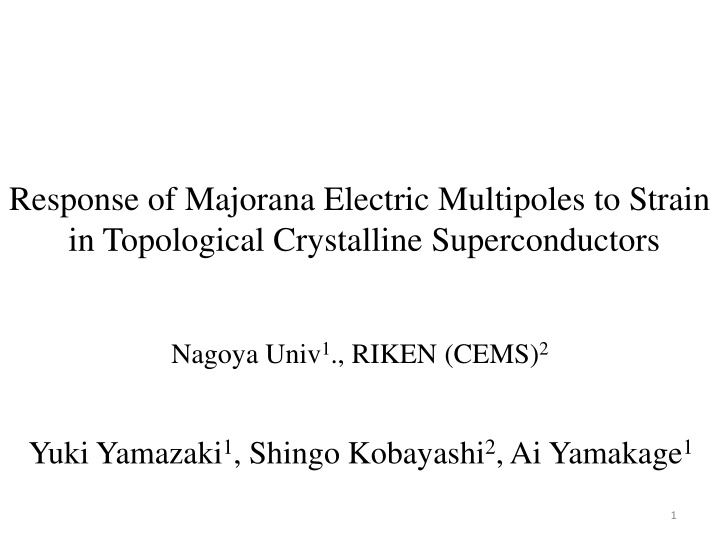
Response of Majorana Electric Multipoles to Strain in Topological Crystalline Superconductors
Investigate the response of Majorana electric multipoles to strain in topological crystalline superconductors. Explore the behavior of Majorana fermions, tunneling conductance, time-reversal symmetry, and the implications of external magnetic fields on Majorana Kramers pairs. Understand the detection and implications of Majorana fermions in superconducting systems.
Download Presentation

Please find below an Image/Link to download the presentation.
The content on the website is provided AS IS for your information and personal use only. It may not be sold, licensed, or shared on other websites without obtaining consent from the author. If you encounter any issues during the download, it is possible that the publisher has removed the file from their server.
You are allowed to download the files provided on this website for personal or commercial use, subject to the condition that they are used lawfully. All files are the property of their respective owners.
The content on the website is provided AS IS for your information and personal use only. It may not be sold, licensed, or shared on other websites without obtaining consent from the author.
E N D
Presentation Transcript
Response of Majorana Electric Multipoles to Strain in Topological Crystalline Superconductors Nagoya Univ1., RIKEN (CEMS)2 Yuki Yamazaki1, Shingo Kobayashi2, Ai Yamakage1 1
E Topological Superconductor (TSC) Bulk A fully or partially (bulk) gapped superconductor with a gapless state on the surface of the system MFs k The surface states behave as a Majorana fermions (MFs) Tunneling conductance Semiconductor nanowire of InSb One-dimensional (1D) TSC MFs on a edge of the system Zero bias peak due to MFs 3D TSC Conductance by PCS in Ag paste part MFs on a surface of the system 2
Topological superconductor with time-reversal symmetry (TRS) MFs form a Kramers pair (Majorana Kramers pair (MKP)) a single MKP is stable for perturbations that do not break the TRS Do MKP necessarily vanish due to breaking of TRS? (applied magnetic field) E E Bulk Magnetic field B MFs k k MKPs remain gapless when a magnetic field is applied in a specific direction (MKPs exhibit anisotropic magnetic response) M. Sato and S. Fujimoto, Phys. Rev. B 79, 094504 (2009). SB. Chung and S.C. Zhang, Phys. Rev. Lett. 103, 235301 (2009). MKPs are protected by crystalline symmetry K. Shiozaki and M. Sato, Phys. Rev. B 90, 165114 (2014). 3
Y. Xiong, A. Yamakage, S. Kobayashi, M. Sato, and Y. Tanaka, Crystals 7, 58 (2017).S. Kobayashi, A. Yamakage, Y. Tanaka, and M. Sato, Phys. Rev. Lett. 123, 097002 (2019). TRS + Crystalline symmetry Topological crystalline superconductor TCSC Crystalline symmetry preserving the surface Magnetic winding number Chiral symmetry There is a direction of the magnetic field where chiral symmetry is not broken! Zeeman term Anisotropic Magnetic Response Majorana Magnetic Multipole Bulk B MFs 4
What can we know from the external field response of MFs? Detection of MFs Crystalline symmetry TCSC B superconducting symmetry Identification of superconducting symmetry 5
Majorana Electric Multipole (MEM) TRS Only a single MKP is stable Coupled only with magnetic field Majorana Operator TRS + Crystalline symmetry In some cases, double MKPs are stable Y. Yamazaki, S. Kobayashi, and A. Yamakage, J. Phys. Soc. Jpn. 89, 043703 (2020). S. Kobayashi, Y. Yamazaki, A. Yamakage, and M. Sato, Phys. Rev. B 103, 224504 (2021). Owing to the crystalline symmetry, there are electric multipoles with various symmetries Bulk Magnetic field MFs Electrical external field 6
Purpose of our study To reveal the symmetry of the Majorana electric multipole for all wall paper groups (WGs) and pair potentials Y. Yamazaki, S. Kobayashi, and A. Yamakage, J. Phys. Soc. Jpn. 90, 073701 (2021). Result Detection of MFs Crystalline symmetry superconducting symmetry Identification of superconducting symmetry 7
Coupling between Majorana Electric Multipoles (MEM) and Strain We consider the strain tensor as a perturbation coupled to the MEM Lattice displacement field Unsymmetrized strain tensor Transformation property by the symmetry operator g When the electric multipole and belong to the same irreducible representation, they are coupled, and the coupling can be described as where denotes irreducible representations of , and i corresponds to the degrees of freedom of the MEM; i=1,2 for two pairs of MKPs. Electrical external field 8
Coupling between Majorana Electric Multipoles (MEM) and Strain In this study, we consider as an effective model an antiperovskite that is a candidate material for TCSC, and where double MKPs can appear on the (001) surface T. Kawakami, T. Okamura, S. Kobayashi, and M. Sato: Phys. Rev. X 8, 041026 (2018). point group Oh Effective model The matrices reflect multi-orbital properties Inversion symmetry The (001) surface respects the p4m symmetry M. Oudah, A. Ikeda, J. N. Hausmann, S. Yonezawa, T. Fukumoto, S. Kobayashi, M. Sato, and Y. Maeno: Nat. Commun. 7, 13617 (2016). If the strain of or is applied, it couples to the MEM, and an energy gap opens 9
In this situation, we consider the following perturbation Perturbation Hamiltonian A1irrep B1 irrep 10
Summery We have revealed the relation between the symmetry of Majorana Electric multipole and irreducible representation of the superconducting pair potential for all wall paper groups We consider the lattice strain as an electrical perturbation and numerically clarify the coupling with the Majorana electric multipole Future works Return to the bulk theory, and derive the microscopic mechanism of the coupling between the strain and MKPs Consider dynamical strains such as induced surface acoustic waves, and calculate the spin currents and heat currents generated by dynamical strains 11
